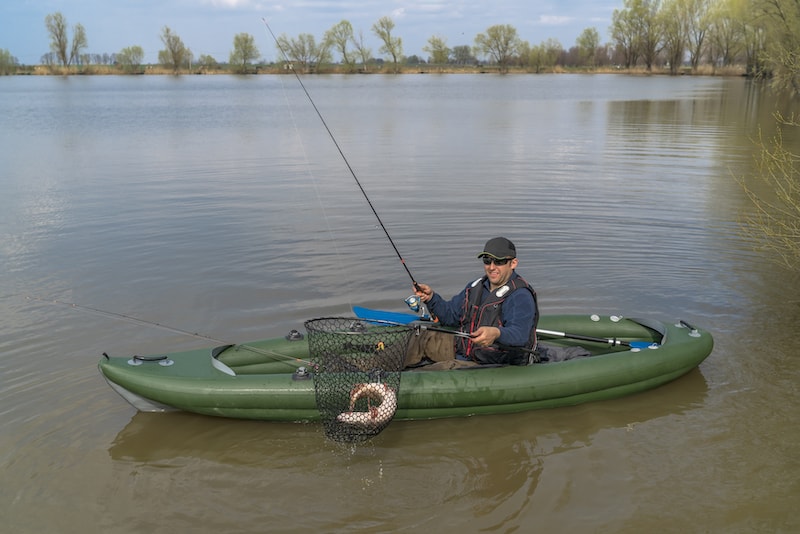Inflatable kayaks are a great option for those looking at dipping their toe into the water and buying a kayak. They have many benefits but they’re not as common as their hardshell counterparts. Many paddlers have never even seen one in person, and they aren’t aware of what the best inflatable kayaks on the market are and other types available. What’s more, many people shop for and order these boats online, so you can’t see the quality of materials used or gauge their durability.
A common question we get asked is are inflatable kayaks safe and in this post we’ll be taking a look at how they’re built and some things to keep in mind when looking at inflatable kayaks.
Advantages of Inflatable Kayaks

In the inflatable kayak vs hardshell debate, a common question is what are the advantages of inflatables. All boats represent some sort of compromise, and not every kayak is right for everybody. Inflatable kayaks solve the age-old kayak storage problem. By deflating and rolling up small, people who have small cars or small apartments can keep a kayak. They set up quickly, usually in less than 15 minutes or so, so their primary benefit is one of convenience.
The compromise made is that they aren’t as sturdy as a plastic or fiberglass hull. And while some inflatables handle very well, paddling them isn’t the same as paddling a hard boat.
It’s important to make a distinction here between the different types of inflatable kayak that you can find. The quality of the inflatable kayaks available varies greatly. There are boats made of thin plastic and shaped like bathtubs, and they handle about as well. On the other end of the spectrum, there are robustly-built boats that look very much like hard boats. These kayaks are generally more seaworthy and more fun to paddle.
Inflatable Kayak Construction

Inflatable kayaks are much more advanced and hard-wearing than the pool toys or inflatable mattresses that many people associate with the word “inflatable.” The PVC fabric used is similar to what Zodiac and other inflatable boat manufacturers use. It’s extremely strong and difficult to puncture.
It’s all relative, however. Some manufacturers use lower-quality materials than others. It’s essential to research your purchase carefully.
There are two types of inflatable kayaks. The most common ones use low-pressure inflation, so their hull shapes are more flexible. High-pressure boats use drop-stitched panels that are inflated to pressures more than 10 PSI. This is the same technique used for inflatable paddleboards (iSUPs), and the result is a very rigid and solid-feeling craft. No matter which type you choose, proper inflation is vital. It keeps the boat handling well and optimizes your paddling experience.
The last thing you’ll want to consider is how the seams are made between the fabric panels. If any part of the kayak is likely to give you problems, it’s the seams. PVC can be either welded with heat or chemically glued. Welded seams are the standard in the industry. Glued seams have the possibility of letting go after a couple of years, and they are more sensitive to changes in temperature and storage conditions.
Safety Features to Look For in Inflatable Kayaks

There’s a lot to be said for the safety of the inflatable kayak. Since they are full of air, they are much more buoyant than traditional boats. All of that buoyancy makes for a very stable kayak that can carry quite a bit of weight. As long as there’s air in the boat, it’s basically unsinkable.
The most significant safety feature you want to look for in a boat is that it has multiple air chambers. If the worst happens and one air chamber gets punctured, the inflatable kayak should stay afloat thanks to the other unaffected air chambers. The overall quality of your boat is also a significant safety feature. Higher quality vessels are more durable, which means that they’ll be harder to puncture and less likely ever to need to rely on those extra air chambers.
The final safety feature you want to consider is how maneuverable it is. Unfortunately, some inflatables are much closer to floats or toys than to functioning watercraft, and they aren’t designed to handle wind, current, or waves. The boat needs to be able to track well and remain controllable even when conditions aren’t ideal. This is the greatest fundamental safety feature—you need a seaworthy vessel to take you to sea.
Inflatable Kayak Safety Precautions and Tips

When taking an inflatable kayak out, it’s vital to know its limits. How well does it handle wind? Some inflatables lack a defined keel and rely on small fins to stay directionally stable. When this fact is coupled with their lightweight designs, strong winds can play havoc on your paddling plans, so you want to plan your paddles well to ensure you can make it back to your launch point.
While inflatables are very durable, everything has its limits. It’s a good idea to set them up and roll them away on grass or sand, or at least somewhere away from rocks and gravel. Always avoid sharp objects and keep the boat away from heat sources, like the tailpipe of your car.
Proper inflation will significantly affect your paddling experience. If the boat is under-inflated, it will not handle well and will be less stable. Use a pressure gauge until you have a clear idea of how much pumping is necessary to get it right. Here’s a good pressure gauge that will help you get it right.
- NO SWEAT: Getting ready to be active should not be more tiring than the activity itself. The days of manually pumping your board...
- FASTER THAN A HAND PUMP: You can’t physically match the power of this dual stage pump. In the 1st stage it blasts air with a...
- MORE ACCURATE THAN A HAND PUMP: It’s simple. Plug the 12V DC connector into the cigarette lighter of your car, set your desired...
For long-term storage, the more you can keep your inflatable kayak out of the sun, and in climate-controlled storage, the better. Boats stored in the sun will deteriorate quickly due to UV damage. If you store your kayak in a hot area, it can wear the glue out quickly.
Inflatable Kayak FAQs
Do Inflatable Kayaks Pop Easily?
The answer depends on the quality of the kayak. The best inflatable kayaks are made of heavy PVC fabric. This is a synthetic fabric material that is tough, rubberized, and very thick. It takes a lot of force with a very sharp object to puncture it. Of course, some bargain kayaks on the market are made of thin material that will puncture easily, so there is an element of “buyer beware.” To some extent, you get what you pay for.
If you have a high-quality inflatable kayak, then you can expect it to last for years under normal conditions. Short of exposed nails or screws at docks, there’s not much that can puncture your boat. Most rocks should pose no problems, nor should keys, dog toenails, or fishing gear.
If your Inflatable Kayak gets Punctured, can it be Fixed?
In the unlikely event that your kayak does get a hole, it’s surprisingly easy to fix. All inflatable boats come with a simple repair kit with patches and special glue. It’s a matter of cleaning the repair area and gluing a patch on top of the hole. Once the glue sets, the boat should be as good as new. Look for something like this kit from Sea Eagle
- Recommended for Sea Eagle inflatable sport kayaks and SE9 Motormount Inflatable Boats
- Includes two 4 in. x 3 in. white swatches of material and two tubes of glue.
- Repair kit for Motormount boats and Sport Kayaks. Includes two 4 in. x 3 in. white swatches of material and two tubes of glue.
What Happens if the Kayak Fills up With Water?
Inflatable kayaks are much more buoyant than regular kayaks since they are filled with air. Even if your kayak becomes completely swamped, it’s not likely to affect the performance very much. If you capsize, they’re much easier to get upright and bail out than standard kayaks, too.
Can you use Inflatable Kayaks in Whitewater?
Whitewater kayaking is about the most abusive type of paddling there is. You know going in that there’s a high chance that you’ll be dragging your boat over rocks and slamming into things both above and below water. Many inflatable kayaks are up to the task, but you want to do your homework and buy an whitewater ready inflatable that’s designed specifically for rapids. Never take a flat-water kayak into the rapids since it not only may not make it, it may be challenging to handle.
How do you Find a High-Quality Inflatable Kayak?
Since most people purchase inflatables online, it’s important to be an educated consumer. Without being able to see the product in person, it’s really hard to gauge the quality of construction and thickness of the fabric. The provided warranty and return policy are important factors—a high-dollar vessel should have at least a one-year guarantee.
Conclusion: Should You Buy One?
There is a large market for kayaks that can be transported easily. Some paddlers need to store them in small spaces or want to avoid roof-top car carriers or trailers. Inflatable kayaks provide a great way to get on the water quickly and have a fun day out.
Imagine driving to different locations, pulling a suitcase-sized package from your car trunk, and inflating your boat on site. At home, it fits in a closet, taking up no room at all. You can even check them on airline flights. They may not be the perfect kayaks, but with such great portability and easy transport, they can get to places other kayaks can’t.
We love inflatable kayaks for their ease of use, high durability, affordable price and most importantly safety features that make them a good purchase.


